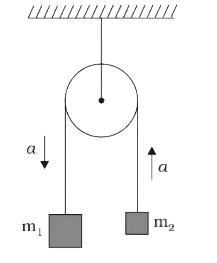After absorbing a slowly moving neutrons of mass (momentum ~0) a nucleus of mass M breaks into two nucleii of mass , respectively . If the de-Broglie wavelength of the nucleus with mass is , then de Broglie wavelength of the other nucleus will be
The correct Answer is:D
To solve the problem, we need to analyze the situation using the principles of conservation of momentum and the de Broglie wavelength formula.
1. Understanding the Problem:
We have a nucleus of mass M that absorbs a neutron of mass mN and breaks into two smaller nuclei of masses m1 and 5m1. The total mass before the reaction is equal to the total mass after the reaction.
2. Setting Up the Mass Equation:
From the problem, we know:
M+mN=6m1
This means that the total mass of the system is conserved.
3. Conservation of Momentum:
Since the neutron is slowly moving, we can assume its momentum is negligible (approximately zero). Therefore, the initial momentum pinitial is:
pinitial=0
After the nucleus breaks into two parts, the momentum conservation gives us:
pinitial=p1+p2=0
This implies:
p1=−p2
4. Relating Momentum to Mass and Velocity:
The momentum of each nucleus can be expressed as:
p1=m1v1andp2=5m1v2
From the conservation of momentum, we have:
m1v1=5m1v2
Dividing both sides by m1 (assuming m1≠0):
v1=5v2
5. Calculating the de Broglie Wavelength:
The de Broglie wavelength λ is given by:
λ=hp
where h is Planck's constant and p is the momentum. For nucleus with mass m1:
λ1=hp1=hm1v1
For nucleus with mass 5m1:
λ2=hp2=h5m1v2
6. Relating the Wavelengths:
Since v1=5v2, we can substitute v1 in the equation for λ1:
λ1=hm1(5v2)=15⋅hm1v2=15λ2
Rearranging gives:
λ2=5λ1
7. Final Result:
If the de Broglie wavelength of the nucleus with mass m1 is λ, then the de Broglie wavelength of the other nucleus (mass 5m1) will be:
λ2=5λ
We have a nucleus of mass M that absorbs a neutron of mass mN and breaks into two smaller nuclei of masses m1 and 5m1. The total mass before the reaction is equal to the total mass after the reaction.
From the problem, we know:
M+mN=6m1
This means that the total mass of the system is conserved.
Since the neutron is slowly moving, we can assume its momentum is negligible (approximately zero). Therefore, the initial momentum pinitial is:
pinitial=0
After the nucleus breaks into two parts, the momentum conservation gives us:
pinitial=p1+p2=0
This implies:
p1=−p2
The momentum of each nucleus can be expressed as:
p1=m1v1andp2=5m1v2
From the conservation of momentum, we have:
m1v1=5m1v2
Dividing both sides by m1 (assuming m1≠0):
v1=5v2
The de Broglie wavelength λ is given by:
λ=hp
where h is Planck's constant and p is the momentum. For nucleus with mass m1:
λ1=hp1=hm1v1
For nucleus with mass 5m1:
λ2=hp2=h5m1v2
Since v1=5v2, we can substitute v1 in the equation for λ1:
λ1=hm1(5v2)=15⋅hm1v2=15λ2
Rearranging gives:
λ2=5λ1
If the de Broglie wavelength of the nucleus with mass m1 is λ, then the de Broglie wavelength of the other nucleus (mass 5m1) will be:
λ2=5λ
Similar Questions
Two bodies of masses m1andm2(<m1) are connected to the ends of a massless cord and allowed to move as shown in figure. The pulley is both massless and frictionless. The acceleration of the centre of mass is (m1−m2)n(m1+m2)2g. Find the value of n.

View SolutionThe de-Broglie wavelength of a particle with mass 1g and velocity 100m/sec is.
View Solution
Knowledge Check
Two particles A1andA2 of masses m1,m2(m1>m2) have the same de-broglie wavelength. Then
Atheir momenta are the same.Btheir energies are the same.Cmomentum of A1 is less than the momentum of A2.Denergy of A1 is more than the energy of A2.A particle of mass 4m at rest decays into two particles of masses m and 3m having non-zero velocities. The ratio of the de Broglie wavelengths of the particles 1 and 2 is
A12B14C2D1
A praticle of mass M at rest decays into two particle of masses m1 and m2, having non-zero velocities. The ratio of the de Broglie wavelength of the particles λ1λ2 is
View SolutionTwo particles A1andA2 of masses m1,m2(m1>m2) have the same de-broglie wavelength. Then
View SolutionA particle of mass 3m at rest decays into two particles of masses m and 2m having non-zero velocities. The ratio of the de Broglie wavelengths of the particles (λ1λ2) is
View SolutionThe atomic masses of He and Ne are 4 and 20 amu respectively . The value of the de Broglie wavelength of He gas at−73.∘C is ''M'' times that of the de Broglie wavelength of Ne at 727.∘C. M is
View SolutionThe de - Broglie wavelength associated with the particle of mass m moving with velocity v is
View SolutionAn electron of mass m and a photon have same energy E. The ratio of de - Broglie wavelengths associated with them is :
View Solution
